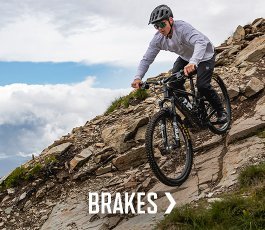Five questions for OneUp Director and Engineer Chris Heynen
We had the chance to talk with OneUp Director and Engineer in Chief Chris Heynen about their platform pedals.
OneUp’s platform pedal sticks out from the competition in many ways from performance to looks. In our interview, the father of the OneUp pedal explains his motivation to build his own version of a crucial touch point on Mountain Bikes.
What are the key characteristics of a great platform pedal for you?
Great characteristics of a flat pedal are the overall size of the platform. Too small and your feet don't feel supported the edge of your foot can feel like it is slightly hanging off. To feel fully supported you want enough width and length in the overall platform to create the planted feel.
Grip is another aspect that is key. Too little and your slipping off in rock gardens. Too much and you cannot re-position your foot when necessary.
Durability, you want a pedal that you can depend on and isn't moving side to side or up and down due to bushing packing out. A pedal that can take a rock strike at high speeds and glance off.
What makes your pedal different from other pedals?
What sets our pedals apart is the shape, size and grip. We've chosen to use a convex shape that really feels natural to the curve of your foot under the arch. To fully feel the support of this design you need to move your foot forward away from the ball of the foot and it instantly feels so planted especially when descending.
On the alloy side we have tried to create the thinnest, grippiest wide plat form pedal that uses full bearings in comparison to what was offered. We were able to accomplish this all in a package that is light weight and easily serviceable with our unique axle bearing arrangement that pulls out all together when disassembled.
With our composite pedals we strove to create a wider and grippier composite pedal than what was offered in the market. The focus was on offering a real wide platform pedal with great value.

Chris tests his own products on the local Sqamish trails.
There are smooth pins, round pins, pins with threads, and then there are your hexagonally shaped pins. What makes them better?
The surface area of the hexagonal pin design is smaller than the threaded portion of the pin which means it penetrates the sole of your shoe easier than just a larger threaded pin for any given force. The hexagonal shape offers sharp edges that also help with penetration by cutting into the rubber easier so you are never floating on top of the pin.
Is there a personal story that you can tie to the OneUp platform pedals?
All the products we design here start with the same questions: What do I want on my bike? What would make my ride better? The terrain we ride here has a lot of sharp steep entrances that make it hard to clip in quickly so I wanted to design a platform that felt secure and playful enabling me to be able to easily plant a foot or dab when I needed to quickly. The BB height of each bike I've purchased over the past five years has only gotten lower and lower which means pedal strikes were only getting more frequent. Creating the thinnest pedal I could to increase ground clearance was a huge objective and why the convex design was investigated as it offers the thinnest leading edges and overall height of any pedal design. We are based in a rain forest that dries out in the summer so good seals and serviceability was high on the criteria to ensure the product would be durable over time.

The forests in the Pacific Northwest are home to some of the world's greatest trails.
How about yourself, do you ride clipless or platform?
I enjoy both clipless and platform but over the past couple years I really prefer riding flats. Especially after designing the pedal I wanted. I love how planted and secure it feels when descending especially with our convex design which really works well when positioned over the arch of your foot. I also feel more confident dropping in on the steep rock slaps and not having to try and clip in as well as for the off chance I need to bail. Over the past couple years I've started getting out to the alpine more on rides which often involves some hiking as well which is also much more comfortable to do with non SPD-shoes.

Chris Heynen is a Squamish local and can frequently be found out on the trails around the Pacific Northwest, testing product and enjoying the great sport of mountain biking.
































